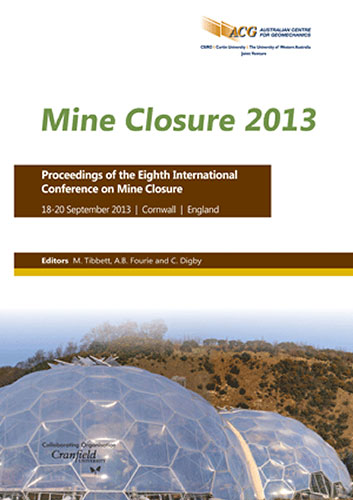Geochemical risk assessment of mine tailings to optimise closure strategy designs

|
Authors: Amissah, NBK; Addo, W; Sam, IA, Sutton, MW; Williams, M Paper is not available for download Contact Us |
DOI https://doi.org/10.36487/ACG_rep/1352_08_Amissah
Cite As:
Amissah, NBK, Addo, W, Sam, IA, Sutton, MW & Williams, M 2013, 'Geochemical risk assessment of mine tailings to optimise closure strategy designs', in M Tibbett, AB Fourie & C Digby (eds), Mine Closure 2013: Proceedings of the Eighth International Seminar on Mine Closure, Australian Centre for Geomechanics, Cornwall, pp. 81-95, https://doi.org/10.36487/ACG_rep/1352_08_Amissah
Abstract:
Gold mining in Ghana has, in several instances, involved significant environmental impacts, including heavy metal contamination of soils, water and food, with attendant risks to ecological systems and human health. A key aspect of impact mitigation following mine closure is the implementation of appropriately protective rehabilitation measures. At AngloGold Ashanti’s Iduapriem mine, a formal risk assessment (RA) approach has been adopted to ensure that mine closure strategies are designed in a manner fully commensurate with the prevailing environmental and toxicological risks. This paper describes this approach with respect to the Interim Tailings Storage Facility (ITSF), which was used for tailings storage from 2009 to 2011. Numerical risk assessment modelling for the ITSF was preceded by the development of a conceptual site model to elucidate all pathways by which communities or individuals may be exposed to deleterious elements derived from the ITSF and to characterise lifestyle, occupational, dietary, cultural and social factors that may directly or indirectly influence human contaminant exposure. In subsequent numerical RA modelling, all source-pathway-receptor linkages were parameterised (quantified) to yield multiple pathway exposure estimates for selected communities. This was undertaken using the RA code RISC5, a model that functions by calculating carcinogenic risk for any given human dose of contaminants of concern through comparison against a slope factor defined clinically or experimentally to express the relationship between intake of individual contaminants and carcinogenesis. Two scenarios were simulated to represent (a) current contaminant exposure levels among residents in local community areas and (b) exposure levels that could potentially arise in response to uncontrolled exposure to contaminants at levels prevailing at the ITSF source. Carcinogenic and non-carcinogenic risk quotients were calculated by comparing model outputs against reference doses from the US IRIS database. Incremental risks associated with long-term exposure to contaminants from the ITSF (in the absence of any active rehabilitation) were then calculated as the difference between risk factors for the two scenarios. Results of the numerical risk assessment show excess lifetime cancer risk probability of 1 case in 10,000 currently prevails in communities at Iduapriem as a consequence of ambient concentrations of arsenic (As) exposure. However, this risk is not attributable to the ITSF, in which As is present at concentrations of 1–2 mg/kg in tailings. The incremental non-carcinogenic risks associated with the ITSF are indicated by RISC5 to be negligible for all contaminants with the possible exception of lead.
References:
FAO (Food and Agriculture Organization of the United Nations) (2006) The State of Food and Agriculture – Food Aid for Food Security, Rome.
Ghana Statistical Service (2009) Comprehensive Food Security & Vulnerability Analysis (CFSVA) World Food Programme, VAM Food Security Analysis 2009, p. 168.
HEAST (Health Effects Assessment Summary Tables) (1997) FY 1997 Update, National Service Center for Environmental Publications, US Environmental Protection Agency, Washington, DC.
IRIS (Integrated Risk Information System) (2011) US Environmental Protection Agency, Washington, DC.
Kawai, K., Saathoff, E., Antelman, G., Msamanga, G. and Fawzi, W.W. (2009) Geophagy (soil-eating) in relation to anemia and helminth infection among HIV–infected pregnant women in Tanzania, American Journal of Tropical Medicine and Hygiene, Vol. 80(1), pp. 36–43.
Nti, C.A. (2008) Household dietary practices and family nutritional status in rural Ghana, Nutrition Research and Practice, Vol. 2(1), pp. 35–40.
Sai, F.T., Davey, P.L.H. and Whitby, P. (1962) A National Food and Nutrition Survey Project, Postgraduate Medical Journal, Vol. 38, p. 112
Schlumberger Water Services (SWS) UK Ltd. (2011) AngloGold Ashanti Iduapriem Limited Interim Tailings Storage Facility Risk Assessment, 51012/R1.
SRK (2011) Hydrogeological and Hydrochemical Assessment for the Greenfields Tailings Storage Facility at Iduapriem Mine, AngloGold Ashanti.
US EPA (US Environmental Protection Agency) (2008) Provisional Peer Reviewed Toxicity Values for Cobalt, August 25.
US EPA (US Environmental Protection Agency) (2009) Provisional Peer Reviewed Toxicity Values for Vanadium and Its Soluble Inorganic Compounds Other Than Vanadium Pentoxide (CASRN 7440-62-2 and Others), September 30.
Vermeire, T.G., Apeldoorn, M.E., de Fouw, J.C. and Janssen, P.J.C.M. (1991) Voorstel to Human-Toxicologische Onderbouwing van C-(toetsings) Waarden, RIVM (Dutch National Institute of Public Health and the Environment), Report Number 725201005.
© Copyright 2025, Australian Centre for Geomechanics (ACG), The University of Western Australia. All rights reserved.
View copyright/legal information
Please direct any queries or error reports to repository-acg@uwa.edu.au
View copyright/legal information
Please direct any queries or error reports to repository-acg@uwa.edu.au